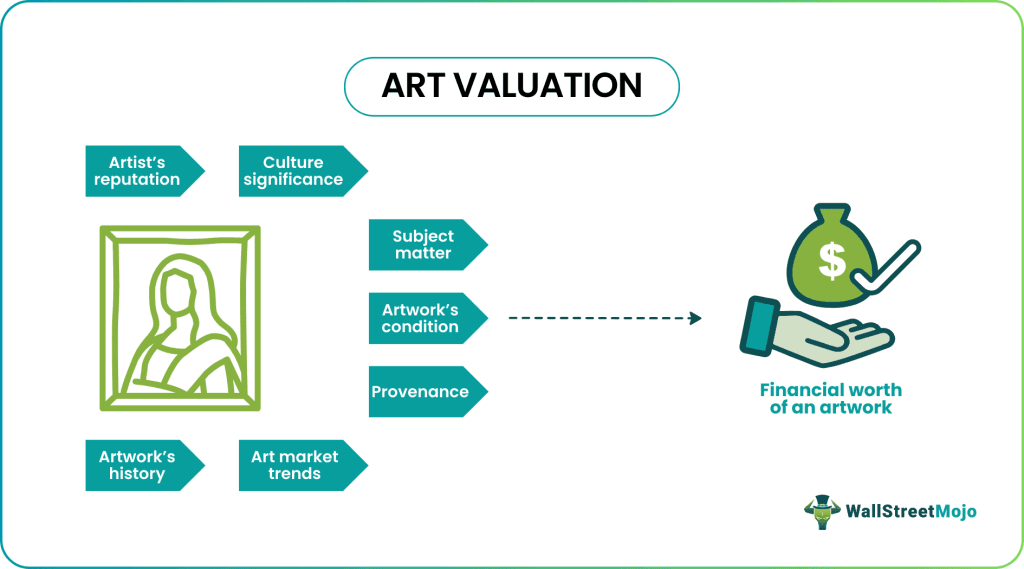Table Of Contents
What Is Art Valuation?
Art Valuation refers to determining the worth of an artwork in monetary terms to arrive at its fair market value. These evaluations consider value from the financial standpoint and cover the intangible aspect of cultural significance since the value of a work of art is highly connected with its historical, social, and aesthetic features.

Art valuation is an independent branch of financial valuation that helps derive value or worth based on art and science. Since such estimation requires in-depth knowledge, research, and experience in the art market, it is often handled by reputable auction houses and art appraisal companies. While the value of pieces of artwork is highly volatile, it may rise considerably with time.
Key Takeaways
- Art valuation is a systematic branch of financial valuation that gauges an artwork's equitable and true worth based on various objective and subjective aspects such as cultural, historical, aesthetic, and social significance.
- It is often performed by designated art appraisers and providers of art valuation services appointed by art appraisal companies or auction houses.
- The key factors influencing such evaluation are the artist's reputation, history, artwork condition, provenance, medium, subject matter, cultural significance, market demand, and art market trends.
- The financial worth of a masterpiece or artwork is estimated at its sale or when the collector dies, divorces, or secures a debt against such a work of art.
Art Valuation Explained
Art valuation can be influenced by objective and subjective views, making the art market a dynamic, sometimes unpredictable field. It involves evaluating several aspects, including the artist's reputation, origin date, the artwork's ownership history, its state of preservation, dimensions, medium, general popularity (demand), and recent sales data for comparable pieces in the art market. Artists, collectors, or investors can sell artwork online or offline at auctions. Some platforms for art valuation online are Artsy, Artfare, and Patreon.
Well-known art appraisal companies or auction houses offer art valuation services and conduct these valuations to establish an approximate value for insurance coverage, potential sale, or charitable donations. It is important to note that art valuation is often subjective, and the values assigned to artworks can fluctuate based on market dynamics and the level of interest in specific artists or art styles.
However, art valuation is a multifaceted and subjective process with several inherent challenges, including subjectivity, limited comparable data, susceptibility to market trends, opacity, authentication difficulties, high costs, emotional ties, economic sensitivity, and legal complexities.
Reasons
The prominent reasons that demand art valuation by specialists in art valuation services are:
- Sales: When an artist, collector, or investor wants to sell their masterpiece at an auction or through any other medium, they need to get it valued to determine its correct price.
- The Three D's: The following three reasons generally bring unfortunate and unexpected circumstances. However, proper valuation of an artwork is needed in such situations to address existing disputes or avoid future conflicts.
- Divorce: When individuals with considerable wealth file for divorce, their art collection requires valuation since a fair property split between spouses is needed.
- Death: Estimating and determining the value of an artwork is crucial for estate planning. After an art collector, investor, or artist's demise, their masterpieces or sales proceeds from selling them are distributed among the beneficiaries at fair market value. Hence, art valuation assumes considerable importance in such situations.
- Debt: Art owners may sometimes collateralize a work of art to secure a loan. This is because popular, rare, or unique pieces of art are valued at high prices, and they facilitate borrowings against them. In such cases, the bank or lender undertakes art valuation to arrive at the equitable price of the mortgage.
Key Factors
Art valuation is a complex process that often combines the following critical determinants while estimating the worth of an artwork:
- Artist Reputation: Well-known artists often command considerable prices for their creations due to their established track record and influential stature in the art world.
- Artistic Significance: A piece's cultural and historical importance can significantly impact its value. Art tied to important movements or periods may be more valuable.
- Rarity: The uniqueness or distinctiveness of a particular artwork can drive up its value. If it is a one-of-a-kind piece or part of a limited series, collectors may be willing to pay more.
- Provenance: A clear and well-documented history of ownership can enhance an artwork's value, primarily if notable individuals or institutions have owned it.
- Condition: The physical state of the artwork is crucial. Well-preserved pieces are more valuable, while restoration or damage can affect value.
- Medium and Technique: The materials and techniques can influence value. For instance, an oil painting might be valued differently from a watercolor or a digital artwork. Also, depending on the type or form of art, such as paintings, collages, abstracts, pop art, photography, and others, valuation experts appraise a piece.
- Subject Matter: The subject of the artwork can also affect its value. Popular or culturally significant topics may be more sought after.
- Art Market Trends: Current trends and demand in the art market can substantially impact valuation. Pieces that enjoy popularity today might not be artwork considered popular today, i.e., they may differ from those that were in demand a decade ago.
- Awards and Recognition: Awards and accolades received by the artist or the artwork can increase its value.
- Exhibition History and Scale: Being featured in prestigious exhibitions or museums can enhance an artwork's reputation and value. The more prestigious an exhibition, the higher the value usually assigned to the corresponding artwork.
- Authentication: Ensuring the authenticity or originality of an artwork is crucial. Verified masterpieces typically command higher prices.
- Cultural Factors: Cultural significance, including the aesthetic, historical, and social relevance of an artwork, affects how its value is perceived, estimated, and valued.
- Emotional Appeal: Personal or emotional connections to artwork can encourage collectors to pay a premium.
Examples
Here are a few examples that throw light on the relevance and significance of art valuation.
Example #1 - Microsoft's Windows Desktop Background
Microsoft's epic Windows desktop background showcasing the Northern California landscape is the best example to cite here. It was clicked by a photographer named Charles O' Rear using a medium format camera. Microsoft purchased the picture for so high a price that it could not make arrangements for transit insurance. Finally, O'Rear had to hand-deliver it. The artwork was valued based on the color theme and the beautiful representation of sky and ground in the right proportion, exemplifying blue sky and green grass in a single frame.
Example #2
Imagine a famous Jewish sculpture artist created a sculpture of a mother and infant in the 1600s. The statue was kept at a museum for public viewing for years. In 1997, the sculpture was auctioned for $1.2 million. In 2020, it was sold in a private sale for $2 million. The price it attracted was based on its perceived historical value and the artist's reputation regarded across centuries.
Example #3 - Gustav Klimt, Birch Forest (1903)
At an auction held in 2023, the Birch Forest painting sold for $104.6 million at Christie's in New York. The key factors influencing its pricing were the reputation of the artist Klimt. The painting showcased his signature style of portraying nature, intricate patterns, and vibrant colors. The work of art was created in 1903, which added heavily to its historical value. Moreover, it was a treat for nature lovers, appealing to their beliefs and emotions.
Importance
Art valuation has diverse roles in art, including financial, legal, and cultural prospects. It is significant for the following reasons:
- Investment: Art collectors and investors rely on this estimation to make informed decisions about purchasing, selling, or retaining artworks as it affects their financial interests.
- Insurance: Accurate valuation is essential for obtaining insurance. It ensures that the artwork can be adequately covered in case of loss, theft, or damage.
- Estate Planning: Art valuation plays a significant role in estate planning, helping in the fair distribution of assets among successors in case of the owner's demise. It is also needed when charitable donations are planned.
- Legal Matters: Art valuation is frequently required for legal purposes, such as divorce settlements, tax assessments, and disputes concerning ownership or authenticity.
- Cultural Heritage: Valuation is essential for preserving cultural heritage, assisting museums and institutions in assessing the value of their collections for conservation, restoration, and funding.
- Artists and Galleries: Artists and galleries can benefit from noting the value of their collection in monetary terms, as it aids in developing useful pricing strategies and supports marketing efforts. It also helps galleries establish a reputation in the art world.
- Market Trends: Valuation data contributes to deriving, analyzing, and interpreting art market trends, which is valuable for art professionals, collectors, and policymakers.

